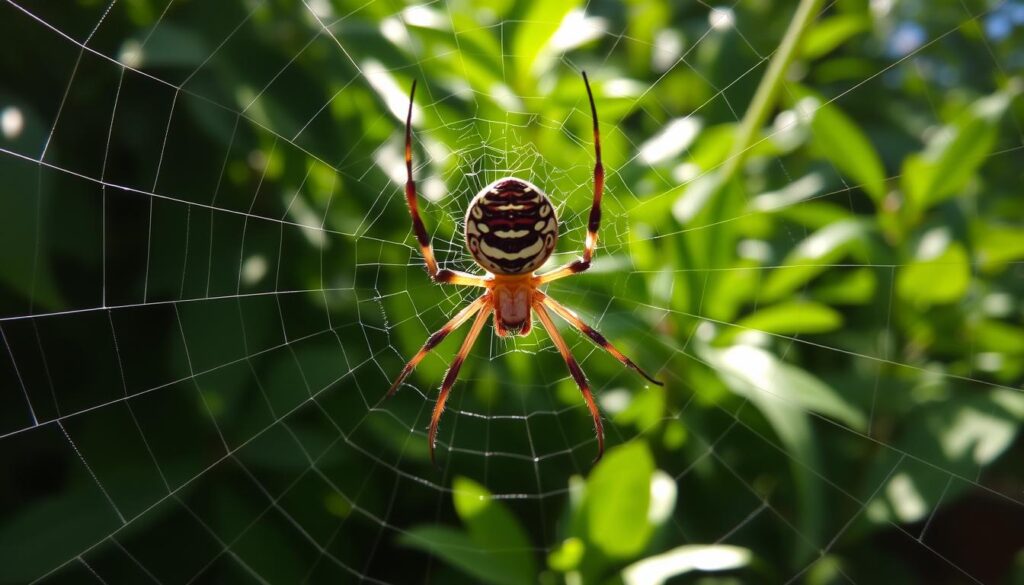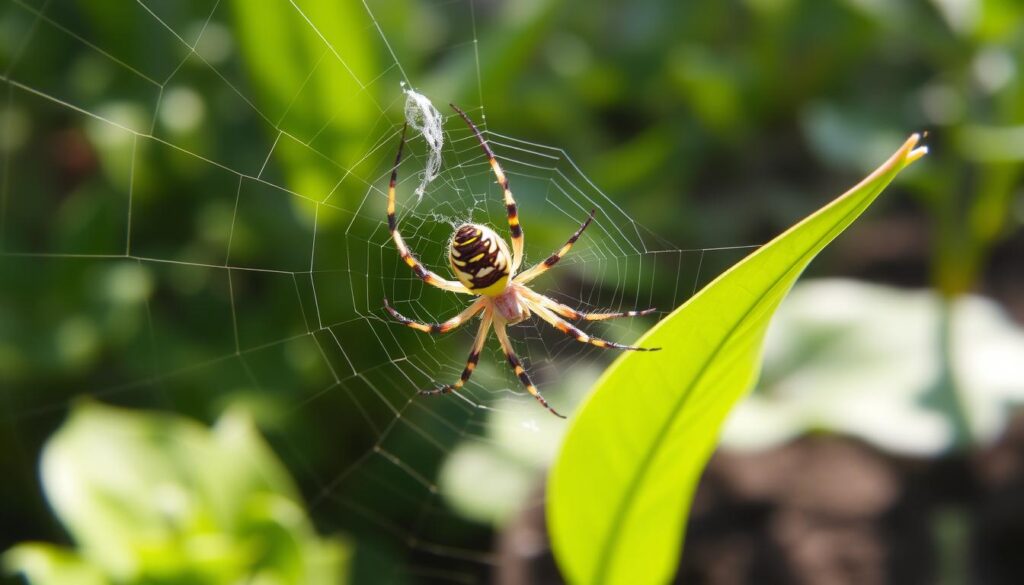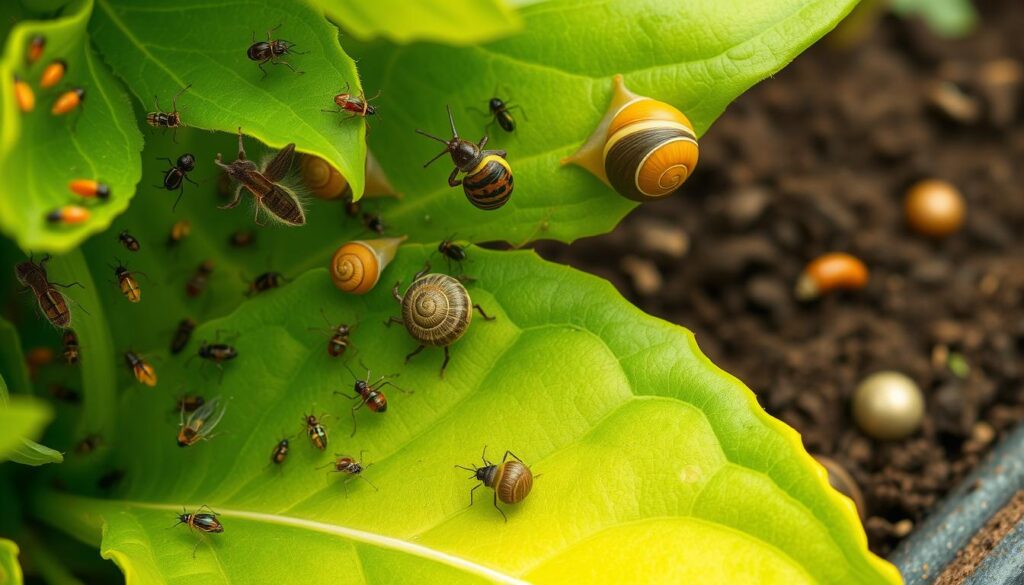Did you know many spiders live in homes, with numbers from 50 to hundreds? Bringing a garden spider (Araneus diadematus) as a pet might seem interesting. But, it’s important to know the risks and challenges first. Garden spiders are great at making webs and are fun to watch. Yet, their care needs and how long they live indoors are key to consider.
Keeping a garden spider indoors can mess with its natural life and habits. There are also big questions about taking it from its home. You need to think about the right place to keep it, how to handle it, and when to let it go back outside.
Key Takeaways
- Garden spiders are adapted to specific environments and may struggle to survive indoors.
- Bringing a garden spider inside can disrupt its natural behavior and life cycle.
- Proper habitat setup and handling techniques are crucial for the spider’s well-being.
- Ethical concerns exist around removing a garden spider from its natural habitat.
- Timing and precautions are important when releasing the spider back into the wild.
Understanding Garden Spiders
Common Types and Identification
Garden spiders, also known as orb-weaver spiders, are found in many places in the United States. The European garden spider is well-known for its round web and white belly. Other spiders, like the yellow garden spider and wolf spider, are also common.
It’s fun to learn about garden spiders. They build spiral webs using silk. The web’s size and the spider’s look can help you guess the type.
Life Cycle and Behavior
Garden spiders live for about a year. They mate, lay eggs, and hatch young in the spring. A female can lay up to a thousand eggs at once.
These spiders catch prey like aphids and flies by wrapping them in silk. They then break down the prey with digestive enzymes. They also feel vibrations on their webs to catch more prey.
| Species | Characteristics | Habitat |
|---|---|---|
| European Garden Spider (Araneus diadematus) | Distinctive circular web, white markings on abdomen | Gardens, parks, wooded areas |
| Yellow Garden Spider (Argiope aurantia) | Vibrant yellow and black coloration, large size | Gardens, meadows, open areas |
| Wolf Spider | Agile ground hunters, no web | Grassy fields, forest floors |
“Garden spiders are not aggressive and are not prone to biting unless threatened or trapped.”
The Pros and Cons of Bringing a Garden Spider Indoors
Keeping a garden spider as a pet has both good and bad sides. On the plus side, you get to see its web-building and life cycle up close. It also keeps it safe from harsh weather and predators.
Potential Benefits
Watching a garden spider spin its web is amazing. Female yellow garden spiders can make webs up to 2 feet wide. It’s both fascinating and educational.
Also, an indoor home might keep the spider safe from dangers outside. This is especially true for male yellow garden spiders, which are quite small.
Risks and Challenges
But, there are downsides to keeping a garden spider indoors. Taking it away from its natural home can mess with its life cycle. Female yellow garden spiders usually have two breeding seasons a year. They also protect their eggs with silk, which might not happen indoors.
There are also big ethical questions about taking a spider from its home. Garden spiders are vital to their ecosystems. Plus, yellow garden spiders can bite if they feel threatened. This could be risky for people, especially kids, older folks, and those with allergies.
So, deciding to keep a garden spider indoors is a big choice. You need to make sure you can provide the right home, food, and eventually release it back into the wild. This is key to keeping the spider safe and avoiding risks.
can you bring a garden spider inside
It’s possible to bring a garden spider indoors, but there are important things to think about first. There are no laws against keeping garden spiders as pets. But, it’s important to consider the ethics of taking them from their natural home.
Garden spiders need specific things to live, like the right habitat and food. It can be hard to meet these needs in a home. You must think about the spider’s health, its natural life cycle, and how to care for it properly before bringing it inside.
Factors to Consider
- Habitat Requirements: Garden spiders love the outdoors where they can build webs and catch insects. It’s hard to create this environment indoors.
- Lifespan and Life Cycle: Bringing a garden spider inside might mess with its natural life. It could live shorter or not reach certain stages.
- Ethical Concerns: Taking a spider from its home can hurt the local ecosystem. These spiders help control insect numbers. Think about the impact before bringing one inside.
While it’s possible to keep a garden spider indoors, it’s crucial to think about the pros and cons. Make sure the spider’s health and the environment are not harmed.

| Factors | Considerations |
|---|---|
| Legality | No specific laws prohibiting keeping garden spiders as pets |
| Habitat Requirements | Challenging to replicate outdoor conditions indoors |
| Lifespan and Life Cycle | Potential disruption to natural development and longevity |
| Ethical Concerns | Removing spiders from ecosystem can impact local insect populations |
Preparing a Temporary Enclosure
If you decide to bring a garden spider indoors, you need to prepare a good temporary home. The container should be big enough for the spider to build its web. It should have lots of vertical space and the right kind of ground.
A clear plastic container or a glass tank with a tight lid are great choices. They let you watch the spider easily and keep the air moving.
Choosing the Right Container
Choosing the right container for your garden spider is key. Here are some tips:
- The container should be big enough for the spider to build its web. A minimum size of 10 gallons is recommended for most garden spider species.
- Opt for a clear container, such as a plastic or glass tank, to enable easy observation of the spider’s behavior and web-building activities.
- Ensure the container has a secure lid or cover to prevent the spider from escaping. A well-fitting mesh or screen top works well.
- Consider adding decorative elements like branches, leaves, or artificial plants to create a more naturalistic environment for the spider.
- Thoroughly clean and sterilize the container before use to provide a safe and healthy habitat for your spider.
By choosing the right container and setting up the temporary enclosure, you can make sure your garden spider is happy and healthy while it’s in your care.
Providing Proper Habitat and Food
To keep a garden spider healthy in captivity, you need the right habitat and food. These spiders, like the black and yellow garden spider, eat insects like flies, moths, and beetles. It’s key to feed them live prey, such as crickets, mealworms, or small flies.
Choose prey that matches the spider’s size and needs. Garden spiders can grow to the size of a quarter in diameter, and the females can create egg sacs containing up to 1,400 eggs. They inject venom into their prey and wrap them up before eating.
The enclosure should look like the spider’s natural home. This means using the right substrate, hiding spots, and structures for web-building. The round wheels in a garden spider’s web are sticky and used for catching prey. A good environment helps your spider thrive and behave naturally.
| What Garden Spiders Need in Captivity | Feeding Recommendations |
|---|---|
|
|
Knowing what garden spiders need helps them thrive indoors. These spiders are good for gardens and aren’t harmful to humans. Learning about them can help you appreciate these fascinating creatures.
Handling and Introducing the Spider
When dealing with garden spiders, it’s important to be careful. These fascinating creatures need to be handled gently. This ensures their safety and yours.
Safe Capture Techniques
Don’t touch garden spiders directly. They can get stressed or defensive. Instead, use cardboard or a small container to guide them into a safe space.
When moving the spider to a new place, do it slowly. Sudden actions or loud sounds can upset them. Place the container near the new spot and let the spider come out when ready.
“The banded garden spider, Argiope trifasciata, is 15 to 25 millimeters in length, slightly smaller than the yellow garden spider.”
By using these safe methods, you help the spider adjust well to its new home. This way, it can live happily in its new space.

Always put the spider’s well-being first when handling and introducing it. A gentle and respectful approach lets you enjoy these amazing creatures safely.
Caring for an Indoor Garden Spider
Caring for a garden spider in captivity means paying close attention to its web-building needs. Garden spiders are great at building webs. To help them, you need to give them the right space to build.
Make sure the enclosure is clean and has the right humidity and temperature levels. This helps the spider stay healthy and happy. By doing this, you create a home-like environment for it to build its web.
Web-building and Maintenance
To help your indoor garden spider build its web, follow these tips:
- Give it natural materials like sticks and leaves to build with.
- Use a spray bottle to keep the air humid, as spiders need it to survive.
- Regularly clean the enclosure to keep it tidy, but avoid disturbing the spider’s web.
- Watch how the spider builds its web and adjust the enclosure as needed.
By taking good care of the spider’s web and home, you ensure it stays healthy and happy indoors.
| Habitat Requirement | Optimal Condition |
|---|---|
| Temperature | 55°F to 80°F (13°C to 27°C) |
| Humidity | Above 30% |
| Lighting | Bright, indirect sunlight |
| Substrate | Moist, well-draining soil or substrate |
| Enclosure Size | Minimum of 10 gallons (38 liters) |
By meeting your indoor garden spider‘s habitat needs, you create a space that supports its web-building. This ensures it thrives and adds beauty to your home.
Monitoring the Spider’s Health and Well-being
Keeping a garden spider healthy in captivity needs careful watching. We must observe its behavior and physical state closely. This helps us spot any problems early.
A healthy spider eats well. It will eagerly take live food like crickets. If it doesn’t want to eat, it might be stressed or sick. Watching how it builds its web also tells us a lot about its health.
Also, watching how active the spider is tells us a lot. If it’s very still, it might be upset. But if it’s moving around a lot, it’s probably doing well in its new home.
| Signs of Healthy Garden Spider | Indicators of Stress in Garden Spider |
|---|---|
|
|
By watching the spider’s health closely, we can make sure it’s comfortable. Regular checks and quick action when needed are key to its well-being.
Ethical Considerations
Keeping a garden spider as a pet raises big ethical questions. Garden spiders are not endangered, but taking them from their homes can mess up the local ecosystem. It’s a big decision that could harm the environment.
Impact on the Natural Environment
Garden spiders are key to keeping our ecosystems balanced. They eat insects that could damage our gardens and homes. Taking a spider from its home can upset this balance. It might also make the spider unhappy and shorten its life.
A study in North Carolina found spiders in every home. They help control pests and diseases like mosquitoes. Keeping spiders in our gardens helps control pests naturally.
It’s important to own garden spiders responsibly. This means thinking hard before bringing one home, giving it a good place to live, and releasing it back outside. This way, we can enjoy spiders while respecting their place in nature.
“Spiders are natural inhabitants of indoor ecosystems and are more likely to avoid humans than pose a threat.”
Most spider venom is not harmful to humans, and bites are rare. Still, we should treat them with care. Catching and releasing spiders helps them and the environment.
Releasing the Spider Back to the Wild
When it’s time to let your garden spider go back outside, do it carefully. The timing is key. The spider might find it hard to adjust to the outdoors again after being in a safe place.
Timing and Precautions
Release the spider when the weather is good and food is plentiful. This helps it fit back into its home better.
- Release the spider during the same time of year when you initially found it outdoors.
- Choose a day with mild temperatures and low wind to minimize stress on the spider.
- Ensure the release site is in close proximity to the original location where the spider was found.
Be gentle with the spider and try not to stress it out. Avoid sudden moves or too much handling. This helps it adjust better to life outside.
| Precaution | Importance |
|---|---|
| Timing the release with favorable weather conditions | Ensures the spider can easily access its natural food sources and adjust to the outdoor environment. |
| Releasing the spider near its original location | Helps the spider reintegrate into its familiar territory and avoid disorientation. |
| Handling the spider gently and minimizing stress | Preserves the spider’s natural behaviors and increases its chances of survival in the wild. |
By taking these steps, you can help your garden spider have a smooth return to the wild.
Conclusion
Bringing a garden spider inside can be both fascinating and educational. However, it’s crucial to think about the ethical and practical sides. There are benefits to watching a spider up close, but we must also consider its well-being and the environment.
Setting up the right habitat, handling it carefully, and releasing it back into nature are key. If you decide to keep a garden spider indoors, do it for the spider’s sake. Make sure you’re ready for the responsibility of pet ownership.
Garden spiders are important for controlling insects and keeping ecosystems balanced. By understanding how to care for them, we can make choices that help both the spider and our environment. This way, we can ensure the spider’s well-being and protect nature.
FAQ
Can garden spiders be kept as pets?
Yes, you can keep a garden spider indoors. But, it’s important to think about a few things first. They need a special place to live and food that’s hard to find at home. Also, taking them from the wild can be wrong.
What are the potential benefits of keeping a garden spider as a pet?
Having a garden spider as a pet lets you see how they make webs and grow. It might also keep them safe from bad weather or animals.
What are the risks and challenges of keeping a garden spider in captivity?
Keeping a garden spider indoors can mess with their natural life. You’ll need to make sure they have the right home and food. Plus, it’s not right to take them from where they belong.
How do I set up a temporary enclosure for a garden spider?
Use a clear plastic box or glass tank with a tight lid. Make sure it has enough room for the spider to climb. Add natural things like sticks or leaves to make it feel like home.
What do garden spiders eat, and how do I feed them in captivity?
Garden spiders eat insects like flies and beetles outside. Indoors, you can feed them live food like crickets or small flies. Make sure the food is the right size for them.
How do I safely handle and introduce a garden spider to its new environment?
Don’t touch the spider. Use cardboard or a small container to guide it into its new home. Move it slowly to avoid stressing the spider.
How do I care for a garden spider’s web-building needs in captivity?
Give the spider space and materials to make its web. Add new sticks or leaves to the enclosure to keep it building.
How can I monitor the health and well-being of a garden spider in captivity?
Watch how the spider acts, like if it eats or builds webs. Look for signs of stress or sickness that might mean you need to let it go back outside.
What are the ethical considerations when keeping a garden spider as a pet?
The big worry is taking the spider from its home and hurting the environment. It’s important to care for it well and let it go back outside when you can.
How do I safely release a garden spider back into the wild?
Release the spider when the weather is good and food is plentiful. Handle it gently to help it adjust back to its natural home.



